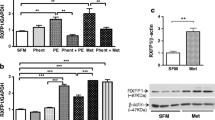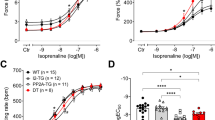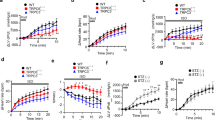Abstract.
(−)-Isoprenaline enhances cardiac contractility through β-adrenoceptors. However, in cardiac tissue from transgenic mice with a 200–400-fold cardiac overexpression of the human β2-adrenoceptor (TG4) we observed a pronounced cardiodepression at high (−)-isoprenaline concentrations. Here, we investigated the functional role of the coexisting β1-, β2-, and β3-adrenoceptor subtypes in several regions of the TG4 heart, and in particular their contribution to the negative inotropic effect. In paced TG4 left atria, (−)-isoprenaline produced bell-shaped concentration-effect curves increasing (−logEC50M=9.0) and decreasing (−logIC50M=6.4) contractile force. These effects were unaffected by the β1-selective CGP 20712A (300 nM). The β2-selective inverse agonist ICI 118,551 (30–1,000 nM) antagonised in surmountable manner both the positive and negative inotropic effects of (–)-isoprenaline with similar concentration-dependence, consistent with an exclusive mediation through β2-adrenoceptors. The β3-adrenoceptor-selective agonist BRL37344 (1 nM–10 μM) failed to produce significant inotropic effects in TG4 left atria. Subsequently, we measured left atrial action potentials accompanying the inotropic changes induced by (−)-isoprenaline. Action potentials tended to have shorter duration in left atria from TG4 mice than from non-transgenic littermate mice. However, (−)-isoprenaline prolonged the duration of 30% repolarisation in atria from non-transgenic littermate but not from TG4 mice, while 90% repolarisation was abbreviated in both groups of atria. Negative inotropic effects of (−)-isoprenaline were also observed in right ventricular preparations. Pertussis toxin-treatment of the mice abolished the negative inotropic effects in left atria and reduced cardiodepression in right ventricle, indicating an involvement of β2-adrenoceptor coupling to PTX-sensitive G-proteins. In additional experiments, designed to study the native murine β1-adrenoceptor function, we used the physiological β1-adrenoceptor agonist (−)-noradrenaline. In the presence of 600 nM ICI 118,551 we failed to find a functional role of the β1-adrenoceptors in left atria, and detected only a marginal contribution to the positive chronotropic effect in right atria. We also investigated the effects of the non-conventional partial agonist (−)-CGP 12177 (0.2 nM–6 μM), which in wild-type mice causes tachycardia through β1-adrenoceptors. In TG4 right atria, however, (−)-CGP 12177-evoked tachycardia was resistant to blockade by CGP 20712A but antagonised by ICI 118,551, consistent with mediation through human β2-adrenoceptors.
The results from TG4 mice suggest that the positive and negative inotropic effects of (−)-isoprenaline are mediated through human overexpressed β2-adrenoceptors coupled to Gs protein and Gi protein, respectively. The (−)-isoprenaline-evoked shortening of the atrial action potential combined with reduced responses of L-type Ca2+ current may contribute to the negative inotropic effects. The function of murine cardiac β1-adrenoceptors is suppressed by overexpressed human β2-adrenoceptors.








Similar content being viewed by others
References
Baker J, Hall IP, Hill SJ (2001) Agonist and antagonistic effects of CGP 12177 on β2-adrenoceptor-stimulated gene transcription in CHO cells transfected with the human β2-adrenoceptor. Br J Pharmacol 134:112P
Blinks JR (1965) Convenient apparatus for recording contractions of isolated muscle. J Appl Physiol 20:755–757
Bond RA, Leff P, Johnson TD, Milano CA, Rockman HA, McMinn TR, Apparsundaram S, Hyek MF, Kenakin TP, Allen LF, Lefkowitz RJ (1995) Physiological effects of inverse agonists in transgenic mice with myocardial overexpression of the β2-adrenoceptor. Nature 374:272–276
Bristow MR, Hershberger RE, Port JD, Minobe W, Rasmussen R (1989) β1- and β2-adrenergic receptor-mediated adenylate cyclase stimulation in nonfailing and failing human ventricular myocardium. Mol Pharmacol 35:295–303
Caulfield MP, Birdsall NJM (1998) Classification of muscarinic receptors. International Union of Pharmacology. XVII. Pharmacol Rev 50:279–290
Daaka Y, Luttel LM, Lefkowitz RJ (1997) Switching of the coupling of the β2-adrenergic receptor to different G proteins by protein kinase A. Nature 390:88–91
Daul A, Hermes U, Schafers RF, Wenyel R, von Birgelen C, Brodde OE (1995) The beta-adrenoceptor subtype(s) mediating adrenaline- and dobutamine-induced blood pressure and heart rate changes in healthy volunteers. Int J Clin Pharmacol Ther 33:140–148
Del Monte F, Kaumann AJ, Poole-Wilson P, Wynne DG, Pepper J, Harding SE (1993) Coexistence of functioning β1- and β2-adrenoceptors in single myocytes from human ventricle. Circulation 88:854–863
Evans KJ, Callaerts-Vegh ZS, Liu RA, Bond RA (2000) Infusions of β2-adrenoceptor antagonists and inverse agonists restores histamine responses in transgenic mice with cardiac overexpression of the β2-adrenoceptor. Br J Pharmacol 131:12P
Gauthier C, Tavernier G, Trochu JN, Leblais V, Laurent K, Languin D, Escande D, Le Marec H (1999) Interspecies differences in the cardiac negative inotropic effects of beta(3)-adrenoceptor agonists. J Pharmacol Exp Ther 290:687–693
Gille E, Lemoine H, Ehle B, Kaumann AJ (1985) The affinity of (−)-propranolol for β1- an β2-adrenoceptors of human heart. Differential antagonism of the positive inotropic effects and adenylate cyclase stimulation by (−)-noradrenaline and (−)-adrenaline. Naunyn-Schmiedebergs Arch Pharmacol 331:60–70
Gong H, Adamson DL, Ranu HK, Heubach JF, Koch WJ, Ravens U, Harding SE (2000) The effect of Gi-protein inactivation on basal, and β1- and β2AR-stimulated contraction of myocytes from transgenic mice overexpressing the β2-adrenoceptor. Br J Pharmacol 131:594–600
Gong H, Sun H, Koch WJ, Rau T, Eschenhagen T, Ravens U, Heubach JF, Adamson DL, Harding SE (2002) Specific β2-adrenergic blocker ICI 118,551 actively decreases contraction through a Gi-coupled form of the β2-adrenergic receptor in myocytes from failing human heart. Circulation 105:2497–2503
Graf EM, Heubach JF, Ravens U (2001) The hyperpolarization-activated current If in ventricular myocytes of non-transgenic and β2-adrenoceptor overexpressing mice. Naunyn-Schmiedebergs Arch Pharmacol 364:131–139
Hall JA, Kaumann AJ, Brown MJ (1990) Selective β1-adrenoceptor blockade enhances positive inotropic responses of endogenous catecholamines through β2-adrenoceptors in human atrial myocardium. Circ Res 66:1610–1623
Heubach JF, Harding SE, Ravens U (1998) Negative inotropic response to isoproterenol in heart muscle from mice overexpressing the β2-adrenoceptor. Circulation 98 [Suppl 17]:I-123
Heubach JF, Trebeß I, Wettwer E, Himmel HM, Michel MC, Kaumann AJ, Koch WJ, Harding SE, Ravens U (1999) L-type calcium current and contractility in ventricular myocytes from mice overexpressing the cardiac β2-adrenoceptor. Cardiovasc Res 42:173–182
Heubach JF, Graf EM, Molenaar P, Jäger A, Schröder F, Herzig S, Harding SE, Ravens U (2001) Murine L-type Ca2+ current is enhanced by zinterol via β1-adrenoceptors, and is reduced in TG4 mice overexpressing the human β2-adrenoceptor. Br J Pharmacol 133:73–82
Heubach JF, Rau T, Eschenhagen T, Ravens U, Kaumann AJ (2002) Physiological antagonism between ventricular β1-adrenoceptors and α1-adrenoceptors but lack of β2- and β3-adrenoceptor function in murine heart. Br J Pharmacol 136:217–229
Kaumann AJ (2000) Gs protein-coupled receptors in human heart. In: Kenakin T, Angus JA (eds) The pharmacology of functional, biochemical, and recombinant receptor systems. Handbook of experimental pharmacology. Springer, Berlin Heidelberg New York, pp 73–116
Kaumann AJ, Lemoine H (1987) β2-adrenoceptor-mediated positive inotropic effects of adrenaline in human ventricular myocardium. Quantitative discrepancies between binding and adenylate cyclase stimulation. Naunyn-Schmiedebergs Arch Pharmacol 335:403–411
Kaumann AJ, Hall JA, Murray KJ, Wells FC, Brown MJ (1989) A comparison of the effects of adrenaline and noradrenaline on human heart: the role of adenylate cyclase and contractile force. Eur Heart J 10 [Suppl B]:29–37
Kaumann AJ, Bartel S, Molenaar P, Sanders L, Burrell K, Vetter D, Hempel P, Karczewski P, Krause E-G (1999) Activation of β2-adrenoceptors hastens relaxation and mediates phosphorylation of phospholamban, troponin I and C protein in ventricular myocardium from patients with terminal heart failure. Circulation 99:65–72
Kaumann AJ, Engelhardt S, Hein L, Molenaar P, Lohse M (2001) Abolition of (−)-CGP 12177-evoked cardiostimulation in double β1/β2-adrenoceptor knockout mice. Obligatory role of β1-adrenoceptors for putative β4-adrenoceptor pharmacology. Naunyn-Schmiedebergs Arch Pharmacol 363:87–93
Kilts JD, Gerhardt MA, Richardson MD, Sreeram G, Mckensen B, Grocott HP, White WD, Davis D, Newman MF, Reves JG, Schwinn DA, Kwatra MM (2000) β2-adrenergic and several other G protein-coupled receptors in human atrial membranes activate both Gs and Gi. Circ Res 87:705–709
Konkar AA, Zhai Y, Granneman JG (2000) β1-adrenergic receptors mediate β3-adrenergic-independent effects of CGP 12177 in brown adipose tissue. Mol Pharmacol 57:252–258
Lemoine H, Schonell H, Kaumann AJ (1988) Contribution of β1- and β2-adrenoceptors of human atrium and ventricle to the effects of noradrenaline and adrenaline as assessed with (−)-atenolol. Br J Pharmacol 95:55–66
Lowe M, Grace AA, Vandenberg JI, Kaumann AJ (1998) Action potential shortening through the putative β4-adrenoceptor in ferret ventricle: comparison with β1- and β2-adrenoceptor-mediated effects. Br J Pharmacol 124:1341–1344
Malinowska B, Schlicker E (1996) Mediation of the positive chronotropic effects of CGP-12177 and cyanopindolol in the pithed rat by atypical β-adrenoceptors, different from β3-adrenoceptors. Br J Pharmacol 117:943–949
Milano CA, Allen LF, Rockman HA, Dolber PC, McMinn TR, Chien KR, Johnson TD, Bond RA, Lefkowitz RJ (1994) Enhanced myocardial function in transgenic mice overexpressing the β2-adrenergic receptor. Science 264:582–586
Molenaar P, Sarsero D, Arch JRS, Kelly J, Henson SM, Kaumann AJ (1997) Effects of (−)-RO363 at human atrial β-adrenoceptor subtypes, the human cloned β3-adrenoceptor and rodent intestinal β3-adrenoceptors. Br J Pharmacol 120:165–176
Molenaar P, Bartel S, Cochrane A, Vetter D, Jalali H, Pohlner P, Burrell K, Karczewski P, Krause E-G, Kaumann AJ (2000) Both β2- and β1-adrenergic receptors mediate hastened relaxation and phosphorylation of phospholamban and troponin I in ventricular myocardium of Fallot infants, consistent with selective coupling of β2-adrenergic receptors to Gs-protein. Circulation 102:1814–1821
Nanoff C, Freissmuth M, Schütz W (1987) The role of a low β1-adrenoceptor selectivity of [3H]-CGP 12177 for resolving subtype-selectivity of competing ligands. Naunyn-Schmiedebergs Arch Pharmacol 336:519–525
Oostendorp J, Kaumann AJ (2000) Pertussis toxin suppresses carbachol-evoked cardiodepression but does not modify cardiostimulation mediated through β1- and putative β4-adrenoceptors in mouse left atria: no evidence for β2- and β3-adrenoceptor function. Naunyn-Schmiedebergs Arch Pharmacol 361:134–145
Pak MD, Fishman PH (1996) Anomalous behavior of CGP-12177 on β1-adrenergic receptors. J Recept Signal Transduct Res 16:1–23
Prendergast CE, Shankley NP, Black JW (2000) Negative inotropic effects of isoprenaline on isolated left atrial assays from aged transgenic mice with cardiac over-expression of human β2-adrenoceptors. Br J Pharmacol 129:1285–1288
Ranu HK, Mak JC, Barnes PJ, Harding SE (2000) G(i)-dependent suppression of beta(1)-adrenoceptors effects in ventricular myocytes from NE-treated guinea pigs. Am J Physiol 278:H1807–H1814
Sarsero D, Molenaar P, Kaumann AJ, Freestone N (1999) Putative β4-adrenoceptors mediate increases in contractile force and cell Ca2+: comparison with atrial responses and relationship to (–)-[3H]-CGP 12177 binding. Br J Pharmacol 128:1445–1460
Sorota S, Rybina I, Yamamoto A, Du X-Y (1999) Isoprenaline can activate the acetylcholine-induced K+ current in canine atrial myocytes via Gs-derived βγ subunits. J Physiol 514:413–423
Wickman KD, Iñiguez-Lluhi JA, Davenport PA, Taussig R, Krapinsky GB, Linder ME, Gilman AG, Clapham DE (1994) Recombinant G-protein βγ-subunits activate the muscarinic-gated atrial potassium channel. Nature 368:255–257
Xiao R-P (2000) Cell logic for dual coupling of a single class of receptors to Gs and Gi proteins. Circ Res 87:635–637
Xiao R-P, Avdonin P, Zhou Y-Y, Cheng H, Akhter SA, Eschenhagen T, Lefkowitz RJ, Koch WJ, Lakatta EG (1999) Coupling of β2-adrenoceptor to Gi proteins and its physiological relevance in murine cardiac myocytes. Circ Res 84:43–52
Zhou Y-Y, Cheng H, Songs L-S, Wang DJ, Lakatta EG, Xiao RP (1999) Spontaneous β2-adrenergic signalling fails to modulate L-type Ca2+ current in mouse ventricular myocytes. Mol Pharmacol 56:485–493
Acknowledgements.
The excellent technical assistance of Romy Kempe and Konstanze Fischer is gratefully acknowledged. This work was supported by a grant of the Deutsche Forschungsgemeinschaft to U. R. (Ra 222/8–2) and by the British Heart Foundation.
Author information
Authors and Affiliations
Corresponding author
Rights and permissions
About this article
Cite this article
Heubach, J.F., Blaschke, M., Harding, S.E. et al. Cardiostimulant and cardiodepressant effects through overexpressed human β2-adrenoceptors in murine heart: regional differences and functional role of β1-adrenoceptors. Naunyn-Schmiedeberg's Arch Pharmacol 367, 380–390 (2003). https://doi.org/10.1007/s00210-002-0681-4
Received:
Accepted:
Published:
Issue Date:
DOI: https://doi.org/10.1007/s00210-002-0681-4




